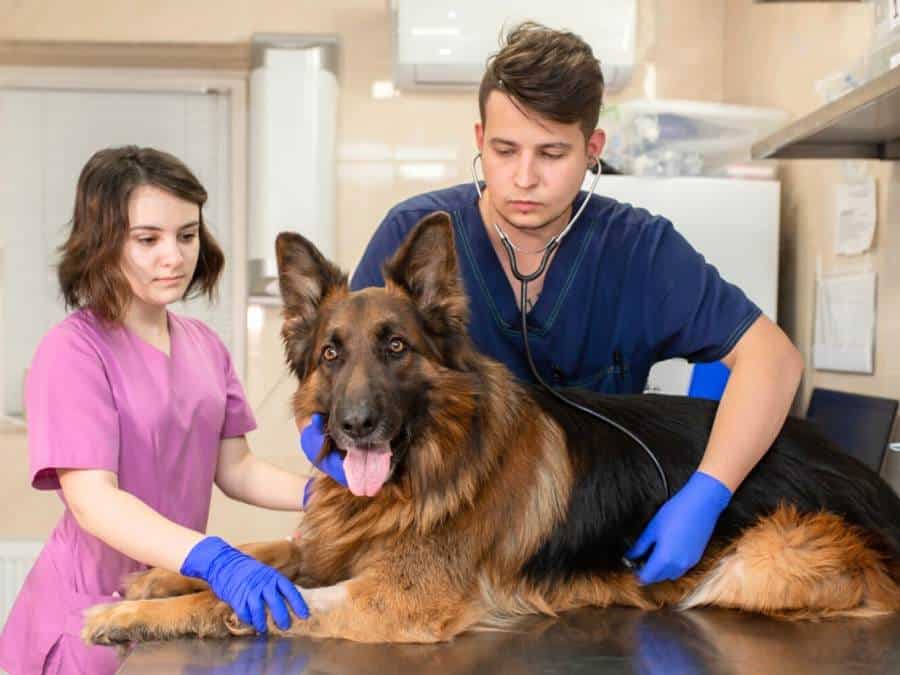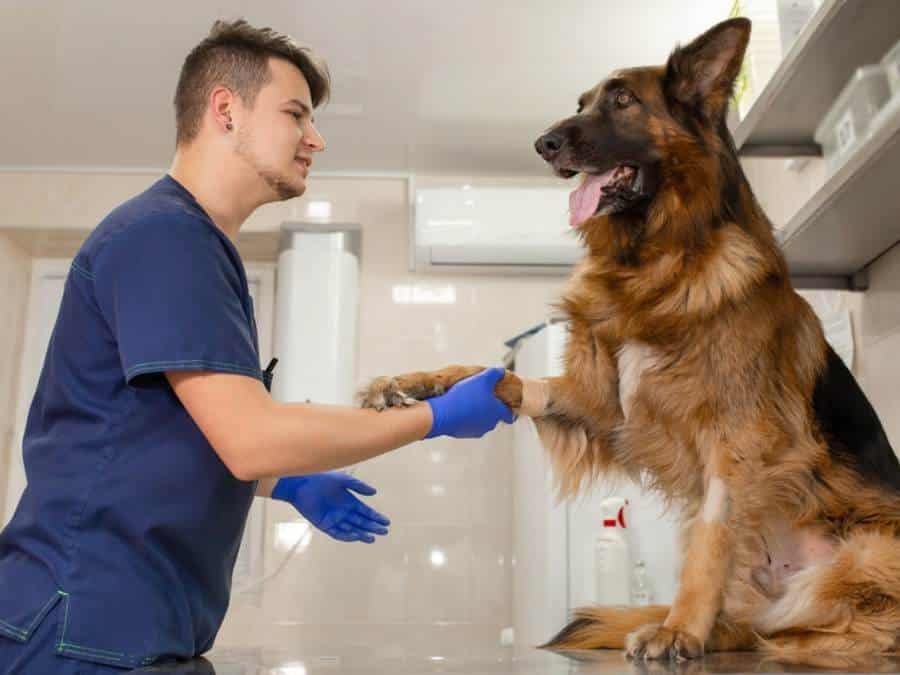Diabetes in German Shepherds is a chronic condition that affects the way your GSD’s body uses glucose, a vital source of energy for cells. Just like in humans, diabetes can significantly impact a dog’s quality of life if not properly managed.
This blog post aims to provide a comprehensive guide on diabetes in German Shepherds, from understanding the condition, recognizing the signs, and exploring treatment options, to managing daily care and prevention strategies.
What is Diabetes Mellitus in German Shepherds?
Diabetes in dogs, also known as Diabetes Mellitus, is a metabolic disorder that occurs when the pancreas doesn’t produce enough insulin or when the body becomes resistant to its effects.
Insulin is a hormone that helps regulate blood sugar levels and allows cells to utilize glucose for energy. Without sufficient insulin, glucose builds up in the bloodstream, leading to high blood sugar levels.
This condition can affect dogs of any age or breed, but it is more common in middle-aged and older dogs.
There are two primary types of diabetes mellitus in dogs:
- Type 1 Diabetes (Insulin-Dependent Diabetes Mellitus – IDDM): This occurs when the pancreas fails to produce enough insulin. This type is more common in dogs.
- Type 2 Diabetes (Non-Insulin-Dependent Diabetes Mellitus – NIDDM): This happens when the body’s cells become resistant to the effects of insulin. While this type is less common in dogs, it can occur.

Symptoms of Diabetes in German Shepherds
Diabetes can manifest through various signs and symptoms in German Shepherds. Here are key symptoms to watch for:
1. Increased thirst
If you notice that your German Shepherd is drinking more water than usual or constantly seeking out water sources, it could be a sign of diabetes.
This excessive thirst occurs because the body is trying to compensate for the increased glucose levels by diluting it with fluids.
2. Frequent urination
If your German Shepherd needs to relieve themselves more frequently or has accidents indoors despite being house-trained, it might indicate diabetes.
The excess glucose in their system leads to an increase in urine production, causing them to urinate more often.
3. Weight loss
Unexplained weight loss can also be a warning sign of diabetes in German Shepherds.
Despite having a good appetite or even an increased appetite, German Shepherds with diabetes may lose weight due to the body’s inability to properly utilize glucose for energy.
This weight loss can occur gradually over time and should not be ignored.
4. Lethargy
If your usually energetic German Shepherd becomes lethargic and lacks their usual enthusiasm, it could be indicative of diabetes.
High blood sugar levels can make them feel weak and fatigued, leading to a decrease in activity levels and overall energy.
5. Recurrent infections
Diabetic Vs are more susceptible to infections due to weakened immune systems caused by high blood sugar levels.
Keep an eye out for recurring urinary tract infections, skin infections, or other types of infections that your dog may develop.
6. Cataracts
According to the American Kennel Club, cataracts, characterized by cloudiness in the eyes, can also indicate diabetes in dogs. High blood sugar levels can lead to changes in the lens of the eye, resulting in vision problems for your furry companion.
RELATED: Why Does My German Shepherd Have Red Eyes?
7. Changes in appetite
Pay attention if your German Shepherd’s appetite suddenly changes without any apparent reason. They may start eating less or lose interest in food altogether.
These changes can be attributed to fluctuating blood sugar levels associated with diabetes.
Other Possible Symptoms
While the aforementioned symptoms are commonly associated with diabetes in German Shepherds, there are other signs that may also indicate this condition:
- Cloudy eyes: Diabetes can cause cataracts or cloudiness in the eyes, which may affect your dog’s vision.
- Poor coat condition: German Shepherds with diabetes may have a dull, thinning coat or experience hair loss.
- Sweet-smelling breath: Diabetes can result in a fruity or sweet odor on your dog’s breath.
If you notice any of these signs in your German Shepherd, it is essential to consult with a veterinarian for an accurate diagnosis and appropriate treatment.
RELATED: Common German Shepherd Diseases

Does My German Shepherd Have Diabetes Quiz?
Is your furry friend showing signs that raise concerns about diabetes? Take the following “Does My Dog Have Diabetes Quiz?” to assess potential symptoms.

What causes diabetes in German Shepherds?
While the exact cause of diabetes can vary and may not always be preventable, awareness of the risk factors can help pet owners manage their German Shepherd’s health more effectively.
Let’s explore the potential causes behind this condition:
- Genetic Predisposition: Certain genetic predispositions can make some German Shepherds more susceptible to developing diabetes.
- Age: Middle-aged to older German Shepherds are at higher risk.
- Obesity: Excess weight significantly increases the risk of developing diabetes.
- Pancreatitis: Chronic or severe pancreatitis can damage the pancreas, affecting insulin production.
- Hormonal Disorders: Conditions like Cushing’s disease (hyperadrenocorticism) or hypothyroidism can influence the development of diabetes.
- Steroid Medications: Long-term use of steroids can induce diabetes by causing insulin resistance.
- Sex: Female dogs and neutered male dogs have a slightly higher risk.
- Diet and Exercise: Poor diet and lack of exercise can contribute to obesity and insulin resistance, increasing the risk of diabetes.
- Other Health Conditions: Other underlying health issues can also increase the risk of developing diabetes.
Managing these risk factors where possible, through maintaining a healthy weight, regular veterinary check-ups, and a balanced diet, can help reduce the risk of diabetes in German Shepherds.
How to diagnose diabetes in German Shepherds?
Diagnosing diabetes in German Shepherds involves various tests and procedures performed by a veterinarian:
- Blood Tests: The primary method used to diagnose diabetes is through blood tests to measure glucose levels. Elevated blood sugar levels (hyperglycemia) are indicative of diabetes.
- Urinalysis: A urinalysis may also be conducted to check for the presence of glucose or ketones in the urine, which could indicate uncontrolled diabetes.
- Glycosylated Hemoglobin Test (HbA1c): This test measures average blood sugar levels over a few months rather than at a single point in time. It provides valuable information about long-term blood sugar control.
- Additional Diagnostic Procedures: In some cases, additional tests may be necessary to rule out other potential causes of symptoms or complications related to diabetes. These may include imaging studies, such as ultrasound or X-rays, to evaluate the pancreas and other organs.

German Shepherd Diabetes Mellitus Treatment
To effectively manage diabetes in German Shepherds, treatment typically involves insulin therapy. This helps regulate their blood sugar levels and ensures they can lead a healthy life.
Alongside insulin, proper management plays a crucial role in keeping diabetic pets happy and active.
1. Insulin therapy
Most German Shepherds with diabetes require insulin injections to control their blood sugar levels. The specific type of insulin and the dosage will be determined by the veterinarian based on the dog’s individual needs.
Insulin is typically administered subcutaneously (under the skin) one to two times per day. The owner will be trained on how to give the injections at home.
It’s important to maintain a consistent schedule for insulin administration and to monitor the dog’s response to treatment.
2. Consistent feeding schedules
Feeding a consistent and balanced diet is crucial in managing diabetes in German Shepherds. Special diabetic dog foods are available, or a veterinarian may recommend a specific diet plan.
Meals should be given at the same times each day, and the dog’s food intake should be closely monitored. Treats and snacks should be limited and factored into the overall diet plan.
3. Monitoring glucose levels at home
Regular monitoring of blood glucose levels is essential to ensure that the insulin dosage is appropriate.
This may involve periodic veterinary visits for blood tests or, in some cases, at-home monitoring using a glucometer.
Owners may be instructed to monitor for signs of hypoglycemia (low blood sugar) and adjust the insulin dosage or food intake accordingly.
4. Regular exercise
Regular, moderate exercise is beneficial for German Shepherds with diabetes. However, it’s essential to maintain a consistent exercise routine and monitor the dog for signs of fatigue or changes in blood sugar levels.
Consistency is key when managing diabetes in German Shepherds. Keeping their daily routines consistent helps regulate their blood sugar levels more effectively.
This includes maintaining regular mealtimes, administering medication at the same time each day, and sticking to a consistent exercise schedule.

What is the prognosis for diabetes in German Shepherds?
The prognosis for German shepherds with diabetes depends on several factors, including the age of onset, the severity of the disease, and the presence of any complications.
Early diagnosis and intervention can significantly improve the prognosis for diabetic German shepherds.
One of the key factors in managing diabetes in German shepherds is maintaining stable blood sugar levels. This involves regular monitoring of blood glucose levels and administering insulin as prescribed by a veterinarian.
It is crucial to follow the treatment plan and make any necessary adjustments to ensure that the dog’s blood sugar levels are within the target range.
Along with medication, a proper diet is also essential for managing diabetes in German shepherds.
Regular exercise is another important aspect of managing diabetes in German shepherds. Exercise helps to control weight, improve insulin sensitivity, and regulate blood sugar levels.
With proper care and treatment, many German shepherds with diabetes can lead happy and fulfilling lives.

What is the life expectancy of a German Shepherd with diabetes?
The life expectancy of German Shepherds with diabetes can vary depending on various factors such as the age at which they were diagnosed, the overall health of the dog, and how well the diabetes is managed.
Generally, with proper care and treatment, German Shepherds with diabetes can live a relatively normal lifespan.
However, it is important to note that diabetes can increase the risk of certain complications such as kidney disease, heart problems, and infections, which can potentially shorten their lifespan.
RELATED: How Long Do German Shepherds Live?
Can puppies develop diabetes?
Yes, puppies can develop diabetes. While it is more commonly seen in older dogs, diabetes can also occur in puppies.
In puppies, diabetes can be caused by genetic factors, certain medications, or underlying health conditions. Symptoms of diabetes in puppies may include increased thirst and urination, weight loss, fatigue, and a decrease in appetite.
If you suspect that your puppy may have diabetes, it is important to consult with a veterinarian for proper diagnosis and treatment.
Managing Diabetes: Daily Care and Monitoring
Effective management of diabetes in German Shepherds goes beyond the initial treatment plan. It involves daily care routines, consistent monitoring, and adjustments as needed to ensure the German Shepherd remains healthy and happy. (PetMD)
Here’s a guide to daily management practices for diabetic German Shepherds:
Consistent Feeding Schedule
Stick to a strict feeding schedule, offering meals at the same times each day to coincide with insulin injections. Avoid free-feeding, and be cautious with treats, ensuring they are accounted for in the dog’s total daily caloric intake.
Administering Insulin Correctly
Learn the proper technique for administering insulin injections. Injections should be given at the same times each day, typically after meals. Rotate injection sites to avoid irritation or scar tissue formation, which can affect insulin absorption.
Regular Exercise
Establish a routine exercise schedule that matches the German Shepherd’s fitness level and is consistent day-to-day. Sudden increases or decreases in activity can cause fluctuations in blood glucose levels.
Blood Glucose Monitoring
Home monitoring of blood glucose levels allows for timely adjustments to insulin doses and helps identify any trends or patterns in glucose levels that may require attention. Discuss with your veterinarian how often to check blood glucose levels and the targets you should aim for.
Recognizing and Responding to Hypoglycemia
Be vigilant for signs of hypoglycemia, such as weakness, lethargy, trembling, or seizures. This condition requires immediate treatment by feeding your dog some fast-acting carbohydrate (e.g., honey or corn syrup) followed by a regular meal.
Regular Health Checks
Regular check-ups with the veterinarian are essential for monitoring your dog’s condition and making any necessary adjustments to their treatment plan.
These visits may include blood work, urine analysis, and discussions about any changes in your German Shepherd’s health or behavior.
By integrating these daily management practices into your routine, you can help manage your dog’s diabetes effectively.

How to prevent diabetes in German Shepherds?
Diabetes in German Shepherds can lead to serious complications if left untreated. Fortunately, there are steps you can take to help prevent diabetes in your furry friend.
Here are some tips to keep your German Shepherd healthy and reduce the risk of diabetes:
- Provide a balanced diet: Feed your German Shepherd a high-quality, balanced diet that is appropriate for their age and activity level. Avoid excessive amounts of treats or table scraps, as these can contribute to weight gain and increase the risk of diabetes.
- Control portion sizes: Be mindful of portion sizes to prevent overfeeding. Follow the recommended feeding guidelines provided by your veterinarian or pet food manufacturer. Adjust the portion sizes as needed based on your German Shepherd’s weight, age, and activity level.
- Promote regular exercise: Regular exercise is essential for maintaining a healthy weight and preventing diabetes. Engage your German Shepherd in daily physical activities such as walks, runs, or playtime. Consult with your veterinarian to determine the appropriate exercise routine for your dog.
- Monitor weight: Keep an eye on your German Shepherd’s weight and body condition. Obesity is a significant risk factor for diabetes in German Shepherds. If you notice your dog gaining weight, consult with your veterinarian to develop a weight management plan.
- Regular veterinary check-ups: Schedule regular check-ups with your veterinarian to monitor your German Shepherd’s overall health. They can assess your dog’s weight, perform blood tests, and provide guidance on preventing diabetes.
- Manage stress: Stress can contribute to the development of diabetes in dogs. Create a calm and stable environment for your German Shepherd, and provide plenty of mental stimulation and social interaction.
- Avoid toxins: Certain medications, chemicals, and toxins can increase the risk of diabetes in dogs. Keep your German Shepherd away from harmful substances and consult with your veterinarian before administering any medications.
Remember, prevention is key when it comes to diabetes in German Shepherds. By following these steps and providing your dog with proper care, you can help reduce the risk of diabetes and ensure their overall well-being.
Conclusion
In conclusion, diabetes in German Shepherds is a complex condition that requires careful management and a committed partnership between pet owners and veterinarians. By understanding the disease, recognizing the signs, and implementing effective management strategies, you can help your diabetic German Shepherd maintain a high quality of life. Always consult with your veterinarian for guidance tailored to your dog’s specific needs and health status.
Also read:




